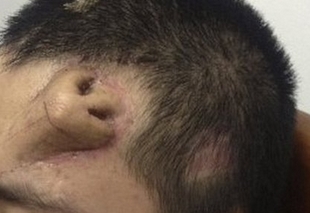On-Site Nose Reconstruction
Interview with
Now, you might have seen in the newspapers this week, pictures showing an individual in  China who has a new nose apparently growing on his forehead. The story goes that some time last year this man was involved in a car accident, and that led to an injury to his face. He then succumbed to an infection in the skin and soft tissues of his nose and this infection destroyed the cartilage of his nose and led to profound disfigurement. So doctors in China in the Fujian province where he lives have resorted to a fairly radical and clever way to repair.
China who has a new nose apparently growing on his forehead. The story goes that some time last year this man was involved in a car accident, and that led to an injury to his face. He then succumbed to an infection in the skin and soft tissues of his nose and this infection destroyed the cartilage of his nose and led to profound disfigurement. So doctors in China in the Fujian province where he lives have resorted to a fairly radical and clever way to repair.
Chris Smith spoke to plastic surgeon Mr Nakul Patel from Addenbrookes Hospital to find out more about the procedure...
Chris - Why would they have grown the nose on his forehead and what's the sort of plastic surgical intervention that is going on here, Nakul?
Nakul - Sure. So, they've used the forehead as a flap, as a block of tissue that's moved down to reconstruct the nose. But prior to that, they've actually used the cartilage from the patient's own ribs to reconstruct the framework that will form the shape of the nose and then thereafter, as a subsequent procedure, they'll transfer this to recreate the nose.
Chris - So, why not just put the cartilage straight onto the face and borrow some skin from somewhere else and build the nose in situ? Why go through this rigmarole of growing a nose up there?
Nakul - It's quite a novel way of doing things. The standard way would be exactly as you've described and they've just tried to differentiate. I think the media has caught the wrong end of the stick in some parts. They've suggested that this new nose has been grown whereas actually it's not necessarily that it's been grown. However, it's just that it's been shaped and placed into the forehead prior to the next operation which is going to be to move it into its correct place.
Chris - How will they do that?
Nakul - So, they take a strip of the forehead tissue, all the way up to the hair line. This technique is well-established. It was sort of described as early 700 BC and then they place it onto the nose. They leave it attached for a period of about 3 weeks. By which time, it has sufficient blood growth from the edges, such that tissue is likely to survive.
Chris - When you say leave it attached - you mean, leave it attached so it's like on a stalk from the forehead and you trim it out and rotate it down. In that way, it takes its bloody supply with it.
Nakul - That's exactly correct. Once it's got its new blood supply from its new home on the nose, they're then able to divide this stalk and place the remainder of the stalk back onto the forehead.
Chris - Why use forehead skin to do that? I mean, apart from the fact there's a blood supply there, is there any benefit of using that part of the body as opposed to any other?
Nakul - Very good question. The forehead skin is a really good match to the rest of the skin of the nose. That's why this procedure that's been done such a long time ago, it's stood the test of time. So, yeah, we continue to use it to this day.
Chris - Is this likely to be successful for him?
Nakul - Looking at the pictures in the media, I think he's got a good reconstruction with regards to the shape of the nose and I'd hope that if all of that survives, he'll have a nice reconstruction.
Chris - What problems could he succumb to when they try to do the final movement?
Nakul - The worry would be, if any of that cartilage doesn't have a sufficiently good enough blood supply, if any of that gets resorbed. In which case, it will lose its shape. If there's any infection, again, the same problem could occur.
Chris - What about closing up the forehead where the nose is at the moment? How will they close the skin together so that you don't leave a gaping nose-sized and shaped hole on the man's forehead?
Nakul - Most of the lower part of our forehead, up close to our eyebrow can be closed directly. So, that will leave a straight line scar. You might well leave a small area on the forehead which is quite high up to heal on its own or place a small skin graft on that.










Comments
Add a comment